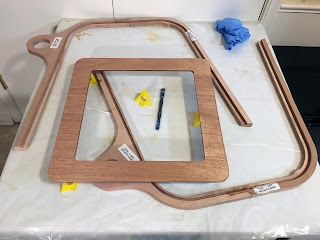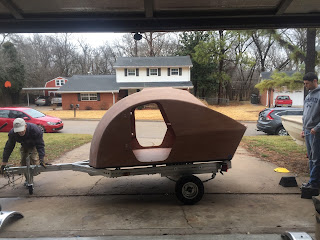Once again I am doing things differently from the method recommended in the manual--in this case because I am working by myself. Each of the hinges has three parts and you are supposed to clamp or tape the doors or hatches in place and mount the three parts using thickened epoxy and super glue to hold them while the epoxy sets. That would be next to impossible to do by myself, especially on the doors.
Forgot to take pictures, but what I did was to put the hatch and doors in place and carefully align them, then mark the hinge sections that attach to them as closely as possible. I then brought them in the house to glue the hinge parts on.
You might be able to see in these pictures that I have also laid the fillets on the hinge sections. The galley hatch has two hinge sections each and a third, extra thick section on the shell. The doors have the single sections on them and the double sections on the shell. The following pictures should help to make this clear.
Here's a shot of part of the galley hatch temporarily mounted and held in place with strapping tape. You can also see a putty knife that is helping to hold the proper alignment. The thicker hinge part has just been tacked onto the camper shell--the two-part section of the hinge is attached to the hatch.
This is a shot of the port-side door held in place with clamps. The two-part hinge sections have just been glued to the shell.
And here is a close-up of the upper hinge. There are dabs of thickened epoxy under the hinge parts. The milky substance is super glue that is holding the hinge parts in place while the epoxy cures. Next I will add fillets around all hinge sections that are attached to the doors and hatch. I have already done the door and hatch fillets. If you look closely you can see part of the upper fillet on the door hinge. This will provide a very strong attachment. I didn't want to put any strain on the newly attached hinges before they cure, but it looks like everything is in good alignment. (I put too much super glue on this hinge. I'll chip some of it away so the much stronger fillet can take its place.)






















